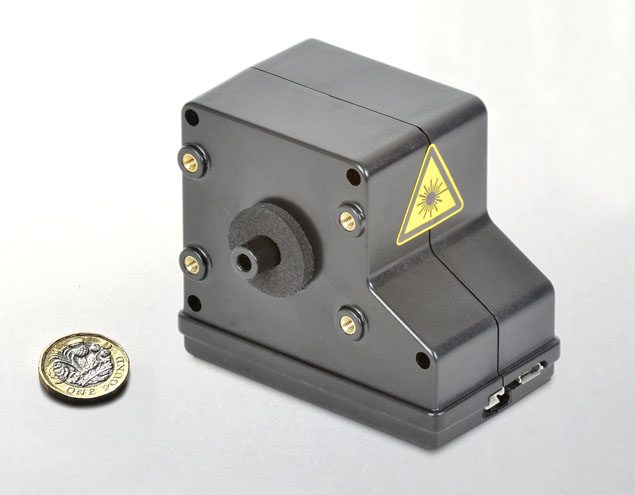
Gas sensor manufacturer Alphasense has launched a new version of its optical particle counter. The new OPC-N3 retains all of the advantages of its predecessor (OPC-N2) with the added benefit of automatic range switching covering PM10, PM2.5 and PM1. With an expanded measuring range (0.38 to 40 µm), the OPC-N3 is able to measure the particulate fractions of most interest; from the finest of particles up to larger particles such as pollen. “This is an extremely important development for manufacturers of air quality monitoring instrumentation,” said Alphasense Director, Arthur Burnley.
“A few years ago, the public was generally unaware of the threat posed by air pollution. However, the many thousands of premature deaths that occur every year in almost every country, have finally caused a high level of media coverage and political interest, and this has led to demands for air quality improvement measures, which in turn have created a need for accurate particulate sensors.
“This bodes well for our customers as the demand rises for small, accurate, reliable, cost-effective particulate sensors.”

Background
In the 1950s developed countries suffered from smoke pollution that could be seen by the human eye. For example, the Great Smog of London was responsible for the deaths of around 4,000 people and led to the development of the Clean Air Act of 1956. This created a number of measures to reduce air pollution, such as the introduction of smoke control areas in selected towns and cities in which only smokeless fuels could be burned. Industrial furnaces could no longer emit ‘dark smoke’ and households were offered grants to convert from coal to smokeless fuel.
The move to cleaner forms of heating, including electricity and gas, significantly lowered levels of particulate and sulphur dioxide pollution. In addition, the Act relocated power stations away from cities, and forced the height of some industrial chimneys to be increased.
Today’s particulate fractions of greatest concern are the finer particles (PM2.5 and now PM1) that cannot be seen by the eye and have to be measured instrumentally. These particles have a major impact on health because they are able to travel deeper into the lungs.
According to the European Commission, some 500,000 people die prematurely in the EU 27 every year; mainly due to exposure to high levels of fine particulate matter (atmospheric microparticles or ‘dust’ of a diameter of less than 2.5 microns), which originates from residential heating, transport (diesel cars and trucks, ships and planes), agriculture, industrial processes and power generation.
Several studies have demonstrated that smaller particles appear to be more toxic than larger particles. Research is focused on understanding the surface chemistry of smaller particulates and their toxic effect on health. Arthur says: “The ability of the OPC-N3 to measure across a wide range of particle sizes, and to auto-range, is therefore very important because it means that accuracy and reliability is retained irrespective of the particle size fraction being measured.”
Urban air pollution
In most countries the major causes of outdoor air pollution are the emissions from diesel vehicles in urban environments, where vehicle movements are concentrated in highway canyons where buildings prevent the dispersion and dilution of pollutants. In these situations, nitrogen oxides and particulates accumulate to levels that exceed the safe levels set by organisations such as the World Health Organisation (WHO) and the European Union.
Traffic conditions, topography and prevailing weather vary between different towns, between different streets and even between different locations on the same street. Consequently, pollution hot-spots exist in most towns and this presents a challenge to those responsible for monitoring air quality. Traditional reference air quality monitoring stations (AQMs) are expensive to install and maintain, so their numbers are limited. Cities and towns need smaller, less-expensive indicative monitors that can monitor at multiple locations within an affordable budget. The data produced by such monitors can be used to track background levels so that the air quality impacts of any new developments can be monitored, and the effects of any initiatives to improve air quality can be measured. The OPC-N3 was developed to meet these requirements for both urban and indoor air quality.
Indoor air pollution
Globally, many of the deaths that are attributed to air pollution arise from indoor particulates. This is because, according to the World Health Organisation, around three billion people still cook and heat their homes using solid fuels (i.e. wood, crop wastes, charcoal, coal and dung) in open fires and leaky stoves. Most are poor, and live in low and middle-income countries. However, the problem is not confined to developing countries; outdoor air travels indoors by natural or assisted ventilation so outdoor pollution directly affects indoor air quality. In addition, indoor wood burners, cookers, toasters and fires can also generate particulate levels that are harmful to health. Again, the flexibility of the OPC-N3 makes it ideal for both indoor and outdoor air monitoring applications.
Sensor development
The OPC-N2 was originally developed at the Centre for Atmospheric and Instrumentation Research at the University of Hertfordshire. Over the following five years, the product was refined through a collaboration between the University and Alphasense. The sensor has also been proven in the field, including for example, the capture of more than 150 million readings at London’s Heathrow airport.
The OPC-N3 measures particulates accurately, repeatedly, and with minimal maintenance using a patented design, providing both particulate matter readings and real-time particle size histograms. As such, the sensor competes in performance with existing analytical units but at a fraction of the cost.
Full technical specifications for the new OPC-N3 are available from www.alphasense.com in addition to detailed information on the company’s other sensors.






